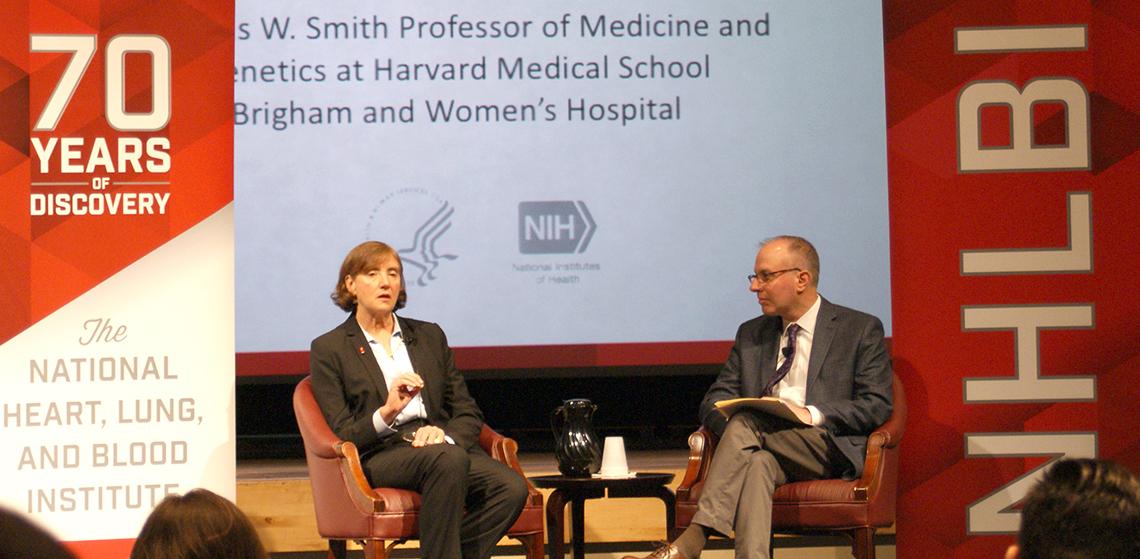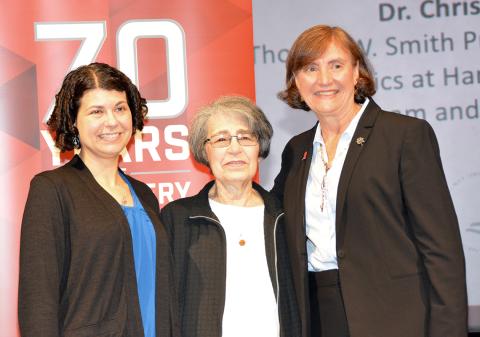NHLBI’s 70th Anniversary
Harvard’s Seidman Discusses Heart Research

Photo: Nichelle Lewis
Dr. Joan Postow is no stranger to cardiology offices. As early as age 3, she was diagnosed with a heart murmur and by age 20 she began experiencing chest pains. Later in life, both she and her brother were diagnosed with hypertrophic cardiomyopathy—a condition in which the heart’s muscular walls become thicker. The thickened walls reduce the heart’s ability to pump blood and increase the risk of heart failure. This is how she came to know and be treated by Dr. Christine Seidman, director of the Cardiovascular Genetics Center at Brigham and Women’s Hospital and a professor at Harvard Medical School.
There are several known causes of heart failure, but for some patients like Postow and her brother, the disease is genetic and can seemingly come from nowhere. Seidman has been studying families who experience this type of out of the blue or idiopathic heart failure to better understand the molecular pathways that might cause more gradual-onset, common kinds of heart failure. In a lecture given recently as part of the NHLBI 70th Anniversary Lecture Series, she talked about her work to identify the genes that contribute to hypertrophic cardiomyopathy (HCM) and dilated cardiomyopathy (DCM), in which the heart muscle becomes thinner.
Work by Seidman and her colleagues implicate gene mutations that impair muscle contraction—and in particular the basic contractile units in muscle, called sarcomeres—as the major cause of genetic cardiomyopathies. They discovered that mutations in a gene encoding a large muscle protein called titin are the most common genetic cause of DCM. Seidman’s lab was able to reproduce these mutations in isolated heart-like cells and found that those cells had far fewer sarcomeres and reduced contractile function, potentially the mechanism for the decrease in pumping contractions seen in patients.
Insight from Spiders
The researchers found that mutations in sarcomere protein genes are also the most common genetic cause of HCM. These mutations commonly cause a small change in the protein myosin, which is the molecular motor of heart cells. Surprisingly, HCM mutations cause small changes in myosin and actually increased the power of contraction instead of reducing it—a phenomenon that did not at first seem to explain patients’ symptoms. That is, until Seidman’s collaborator Dr. Raúl Padrón, an investigator at the Venezuelan Institute for Scientific Research in Caracas, was able to visualize myosin protein from tarantulas, which is remarkably similar to human myosin protein yet easier to isolate, using cryo-electron microscopy.
Working together, these labs were able to deduce specific sections of the myosin protein that are altered by HCM mutations in patients and discovered that these mutations restrict myosin’s ability to fully relax. Poor relaxation of the heart muscle walls can lead to irregular heartbeats, inadequate oxygenation and ultimately wasted energy, so the mutations’ effects turned out to be consistent with the symptoms found in HCM patients.
Sweet Spot of Science
Seidman said that her work to identify gene mutations that cause disease and then conduct laboratory studies to determine their effect on muscle function occupies “a sweet spot of basic science.” Potentially, this knowledge could be used to screen patients who may be more susceptible to cardiomyopathy and provide them with care sooner. However, “The real question and opportunity is can we fix the failing heart?” she asked. Seidman and her colleagues are on their way to answering that question.

Photo: Mark Sampson
By performing a small molecule screen, they discovered a molecule that allows myosin to more fully relax in mouse and human heart cells and protects against the development of HCM in mice that carry myosin mutations.
This part of the lecture was the most fascinating to Postow, who said she is “active and well” after heart surgery in April 2012 arranged by Seidman.
“It gave me hope that better methods will soon be available to treat this disease and that someday it will be possible to prevent it,” Postow said. However, more work is needed before such targeted therapies become available.
“It will require bringing more people into the endeavor and will likely come from discoveries that we never anticipated,” Seidman said.
NHLBI will continue its 70th Anniversary Lecture Series on June 28 with renowned cardiologist and former NHLBI clinical director Dr. Eugene Braunwald.
